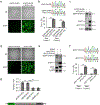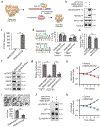Programmable protein expression using a genetically encoded m6A sensor
- PMID: 38168988
- PMCID: PMC11217150
- DOI: 10.1038/s41587-023-01978-3
Programmable protein expression using a genetically encoded m6A sensor
Abstract
The N6-methyladenosine (m6A) modification is found in thousands of cellular mRNAs and is a critical regulator of gene expression and cellular physiology. m6A dysregulation contributes to several human diseases, and the m6A methyltransferase machinery has emerged as a promising therapeutic target. However, current methods for studying m6A require RNA isolation and do not provide a real-time readout of mRNA methylation in living cells. Here we present a genetically encoded m6A sensor (GEMS) technology, which couples a fluorescent signal with cellular mRNA methylation. GEMS detects changes in m6A caused by pharmacological inhibition of the m6A methyltransferase, giving it potential utility for drug discovery efforts. Additionally, GEMS can be programmed to achieve m6A-dependent delivery of custom protein payloads in cells. Thus, GEMS is a versatile platform for m6A sensing that provides both a simple readout for m6A methylation and a system for m6A-coupled protein expression.
© 2024. The Author(s), under exclusive licence to Springer Nature America, Inc.
Figures






References
Methods-only References
-
- Abràmoff MD, Magalhães PJ, and Ram SJ. (2004). Image processing with image J. Biophotonics Int. 11. 10.1201/9781420005615.ax4. - DOI
MeSH terms
Substances
Grants and funding
- R01 AI125416/AI/NIAID NIH HHS/United States
- R01MH118366/U.S. Department of Health & Human Services | NIH | National Institute of Mental Health (NIMH)
- RM1 HG011563/HG/NHGRI NIH HHS/United States
- DP1 DA046584/DA/NIDA NIH HHS/United States
- DP1DA046584/U.S. Department of Health & Human Services | NIH | National Institute on Drug Abuse (NIDA)
LinkOut - more resources
Full Text Sources
Molecular Biology Databases
Research Materials

